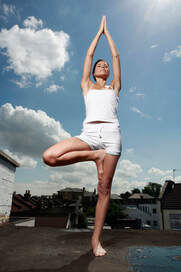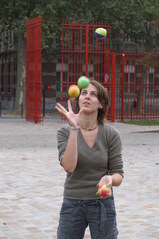Proprioception Training
Proprioception Training
Everyday you move. And if that movement is to be fraught with danger, perhaps you shouldn't. Dangerous movements come when one exceeds their movement capabilities. For most, linear movement is fine, but take them offline every only a degree, and it places their system in danger.
Danger of muscle strains and connective tissue damage, skeletal damage from falls and even serious injury. Preventing this is simple. Using our Proprioception training everyday will allow you to develop your resistance to offline damage and build areas you didn't know you needed.
As we age, our bodies transmission of signals can decrease, unless we strengthen those pathways, we lose ability. Daily practice using proprioception exercises will assist you at any age.
What is Proprioception?
Proprioception is the bodies ability to sense its location in space and time. "Space" being the physical location and "Time" being how long (or short) it will take for you to travel there. A solid measure of your proprioception abilities will be gained when you stand on one leg, raise up on your toes and close your eyes (make sure a wall is close to grab onto when you fall).
A more simple approach is to close your eyes and touch your nose with your index finger. You might think that easy, but there are some who cannot do it. Proprioception also allows you to gauge when you are standing on soft grass or a hard surface in shoes without looking, you just "know" as your proprioception "measures" the surface. It also allows you to throw and catch without looking at the object in flight. It is your bodies ability to "know" where everything is in time and space. Proprioception answers the question "Where is the ball and how long will it take to reach me to catch it?"
Having good proprioception allows you to perform simultaneous and multiple actions are once. Such as running and having a drink of water, playing a sport that requires multiple methods of movement such as basketball; running and dribbling the ball at the same time.
Proprioception is employed with every movement by everybody, but more so with those performing high functional movements such as athletes, dancers, bike riders, cross-fit and martial artists. Poor proprioception makes those activities difficult rather than the joy that they should be.
Danger of muscle strains and connective tissue damage, skeletal damage from falls and even serious injury. Preventing this is simple. Using our Proprioception training everyday will allow you to develop your resistance to offline damage and build areas you didn't know you needed.
As we age, our bodies transmission of signals can decrease, unless we strengthen those pathways, we lose ability. Daily practice using proprioception exercises will assist you at any age.
What is Proprioception?
Proprioception is the bodies ability to sense its location in space and time. "Space" being the physical location and "Time" being how long (or short) it will take for you to travel there. A solid measure of your proprioception abilities will be gained when you stand on one leg, raise up on your toes and close your eyes (make sure a wall is close to grab onto when you fall).
A more simple approach is to close your eyes and touch your nose with your index finger. You might think that easy, but there are some who cannot do it. Proprioception also allows you to gauge when you are standing on soft grass or a hard surface in shoes without looking, you just "know" as your proprioception "measures" the surface. It also allows you to throw and catch without looking at the object in flight. It is your bodies ability to "know" where everything is in time and space. Proprioception answers the question "Where is the ball and how long will it take to reach me to catch it?"
Having good proprioception allows you to perform simultaneous and multiple actions are once. Such as running and having a drink of water, playing a sport that requires multiple methods of movement such as basketball; running and dribbling the ball at the same time.
Proprioception is employed with every movement by everybody, but more so with those performing high functional movements such as athletes, dancers, bike riders, cross-fit and martial artists. Poor proprioception makes those activities difficult rather than the joy that they should be.

How does Proprioception work?
Your bodies central nervous system communicates to the soft tissues (muscles, tendons, ligaments, fascia) using "Proprioceptors" that send information back and forth to the nervous system. When a stretch response is initiated or tension and pressure result from movement, these "Proprioceptors" fire and determine where you should be and when in relation to the sensory input you have obtained.
The process of senses to receptors take far less than a millisecond to occur and in some instances, would be considered a "reflex" action or subconscious action.
Proprioceptors in muscles are called "Muscle Spindles." These work by extending when muscles are elongated (eccentric movement) and conversely when the muscle contracts (Concentric movement) shortens the muscle spindles. The nerves in the spindles transmit where you are and where you should be based on the degree and rate at which the muscle spindle is stretched or relaxed. Think about throwing a ball up in the air just above your head and catching it. This requires your muscles spindles to work in conjunction with your sensory input and muscular contraction to "throw" the ball, then your muscle relaxation and tensioning to "arrest" the moment of the ball upon "catching it." You can probably do this with one ball without really thinking about it. Now think about a jugglers proprioceptive ability and why we must "practice" a skill in order to get good at it. The mere understanding of a thing does not mean we can do that thing, we need to train our proprioception.
Your bodies central nervous system communicates to the soft tissues (muscles, tendons, ligaments, fascia) using "Proprioceptors" that send information back and forth to the nervous system. When a stretch response is initiated or tension and pressure result from movement, these "Proprioceptors" fire and determine where you should be and when in relation to the sensory input you have obtained.
The process of senses to receptors take far less than a millisecond to occur and in some instances, would be considered a "reflex" action or subconscious action.
Proprioceptors in muscles are called "Muscle Spindles." These work by extending when muscles are elongated (eccentric movement) and conversely when the muscle contracts (Concentric movement) shortens the muscle spindles. The nerves in the spindles transmit where you are and where you should be based on the degree and rate at which the muscle spindle is stretched or relaxed. Think about throwing a ball up in the air just above your head and catching it. This requires your muscles spindles to work in conjunction with your sensory input and muscular contraction to "throw" the ball, then your muscle relaxation and tensioning to "arrest" the moment of the ball upon "catching it." You can probably do this with one ball without really thinking about it. Now think about a jugglers proprioceptive ability and why we must "practice" a skill in order to get good at it. The mere understanding of a thing does not mean we can do that thing, we need to train our proprioception.

Proprioceptors in Tendons are called Golgi Tendons Organs (GTO's). Every been hit in the "funny bone?" There is nothing "funny" about it as you all know. That "bump" to your GTO is enough to make it go "dead" for a time and causes pain. Your arm goes "dead" due to the impact to the GTO which shuts off your receptors temporarily. This connective tissue works in conjunction with your muscle spindles and vice versa along with ligaments and fascia on a energetic level of sending and receiving signals based on length, tension, weight and balance. They make hundreds even thousands of micro adjustments each second to simply allow you to "catch" that ball.
Much is still to be learnt about how the soft tissues affect proprioception. Despite all our knowledge of the human body, we only recently (2018) discovered Interstitium Fascia. This gel like structures in our system rapidly changes it viscosity to dissipate sudden force to minimise tissue damage yet is elastic enough to return to normal when the temporary force subsides.
What are Proprioception Exercises?
Teaching or Training your Proprioception is simple, but requires dedicated and daily practice and can stem from something as simple as standing on one leg for a length of time. Your needs will be different from our next clients needs, so we individually tailor bespoke Proprioception Training Programs for each client.
Contact us today to talk about what we can do to Lift You Up!
Much is still to be learnt about how the soft tissues affect proprioception. Despite all our knowledge of the human body, we only recently (2018) discovered Interstitium Fascia. This gel like structures in our system rapidly changes it viscosity to dissipate sudden force to minimise tissue damage yet is elastic enough to return to normal when the temporary force subsides.
What are Proprioception Exercises?
Teaching or Training your Proprioception is simple, but requires dedicated and daily practice and can stem from something as simple as standing on one leg for a length of time. Your needs will be different from our next clients needs, so we individually tailor bespoke Proprioception Training Programs for each client.
Contact us today to talk about what we can do to Lift You Up!